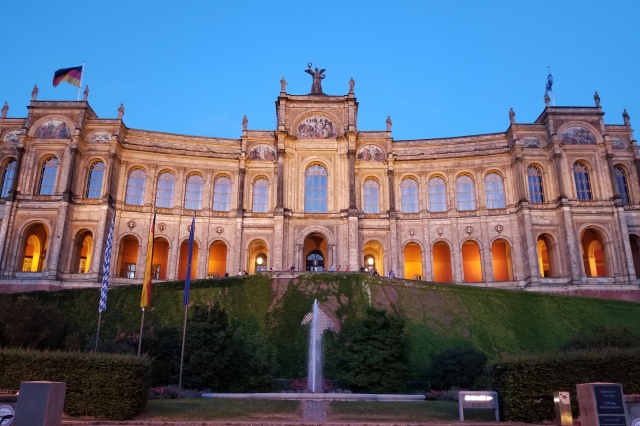August 2018
A TASTE OF BAVARIA
One of the great joys of travelling is the people you meet along the way. I met Chris in Nicaragua, and we decided to be the kind of friends who wouldn’t just slam a few beers at a hostel once, add each other on Facebook and never speak again. So when Chris was in the United States, he visited me at home in Ottawa. And when I was in Central Europe, I visited him at home in Germany.
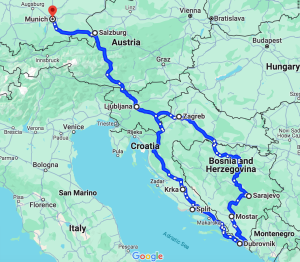
I arrived by the one and only Flixbus after a short stay in Zurich, passing through a stunning southern Germany landscape of vineyards, painted houses, old churches, beautiful bridges, and bright blue lakes. I had not expected to cross one, however, and was caught off guard when I realized the bus was rolling onto a massive boat to cross the Bodensee from Konstanz to Meersburg. From there, it was all grapes, sunflower fields and apple trees until we merged onto the autobahn to Munich.
Once I reached Munich, I had another 2,946 kilometres (give or take) to go on on a two-week trip to Slovenia, Croatia, Bosnia, Austria and back again.
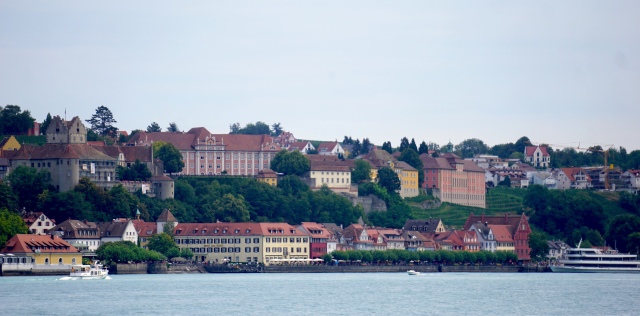
Day One: Munich
Chris was there to greet me at the Munich central bus station with a great big smile. This would be our third reunion after resolving to stay friends in San Juan del Sur in 2017. We took the S-Bahn to his apartment and started the welcome tour of Munich almost straight away. I was nervous about zipping around the city on a bicycle; I’ve always found commuter cycling to be an extreme sport. Then again, Germany is much more accommodating of cyclists than Canada.
We began with the Aldstadt at the core of the Bavarian capital. Marienplatz has been its crowning jewel since its foundation in 1158. The town square has had many names over the centuries, used as market, a venue for tournaments, and today, a historic site that draws millions of tourists each year. At the height of the season in August, it was teeming with people. Every time I tried to get a stoic picture of anything, three dozen others walked into the the frame. I gave up, so please enjoy my photos of other tourists:
At the centre of Marienplatz are the Mariensäule and Neues Rathaus — Mary’s Column and the New Town Hall. The former, erected in 1638, is topped with a golden statue of the Virgin Mary balancing on a crescent moon. The latter is an ornate, neo-gothic municipal building of brick and shell limestone, built between 1867 and 1874. Its tower balcony is home to the world-famous Glockenspiel clock, which, at 11 a.m. and 12 p.m. daily, chimes out 12-minute productions on Munich’s history using 43 bells and 32 twirling, life-sized figurines.
 On the east side of the square is the Altes Rathaus (Old Town Hall). Its white exterior is a reconstruction, the original having been virtually levelled during the Second World War. The first edition dates back to the 14th century, and was the seat of Munich’s city council until 1847. Today, it functions both as a historical toy museum and event space for the municipality.
On the east side of the square is the Altes Rathaus (Old Town Hall). Its white exterior is a reconstruction, the original having been virtually levelled during the Second World War. The first edition dates back to the 14th century, and was the seat of Munich’s city council until 1847. Today, it functions both as a historical toy museum and event space for the municipality.
We cycled next through Odeonplatz, a regal square on the north end of the Aldstadt. It’s home to a royal residence, city palaces, a courtyard garden, a bazaar, the bright yellow Theatine Church, and the historic Feldherrnhalle.
 Today, people sit on the Feldherrnhalle steps to watch passersby, check their phones or straddle the sculpted lions that guard the entrance, but it was not so long ago that a real battle took place there. The loggia was commissioned in 1841 by the King of Bavaria to honour the Bavarian army, and in 1923, it was the site of a failed Mussolini-inspired attempt to overthrow the Bavarian government, known as the Beer Hall Putsch. On Nov. 9, 1923, Adolf Hitler led some 2,000 of his supporters to the Feldherrnhalle to storm the Bavarian Defence Ministry, resulting in a clash with local police that left 16 Nazis dead, four officers wounded, and an eventual prison term for Hitler.
Today, people sit on the Feldherrnhalle steps to watch passersby, check their phones or straddle the sculpted lions that guard the entrance, but it was not so long ago that a real battle took place there. The loggia was commissioned in 1841 by the King of Bavaria to honour the Bavarian army, and in 1923, it was the site of a failed Mussolini-inspired attempt to overthrow the Bavarian government, known as the Beer Hall Putsch. On Nov. 9, 1923, Adolf Hitler led some 2,000 of his supporters to the Feldherrnhalle to storm the Bavarian Defence Ministry, resulting in a clash with local police that left 16 Nazis dead, four officers wounded, and an eventual prison term for Hitler.
SURFING IN THE CITY
The afternoon took a lighter turn as we made our way to the city’s bright green Englischer Garten (English Garden). The dedication to publicly-accessible green space in Munich is enough to make any stifled city-dweller salivate, and it’s not even one of Germany’s greenest cities. The residents of Munich use the space well for exercise, lounging, music, drinking, swimming, and surfing.
My jaw almost dropped as we followed the Eisbach (Isar River) through the park to where it meets Prinzregentenstraße, right across from the Haus der Kunst national museum. I had knew surfing was possible in a river, let alone in a landlocked urban centre. Yet here it was: lineups of young people, braving frigid waters for a 60-second ride on artificial waves — the result of natural current mixed with concrete blocks submerged under a bridge, stabilized by well-placed wooden planks.
Surfing is only one of the Englischer Garten’s delights; others include sandy urban beaches by the Eisbach, a Japanese teahouse celebrating the 1972 Summer Olympics, the reconstructed 18th-century Chinese Tower (which conveniently shares its grounds with a beer garden), and the hilltop Monopoteros temple.
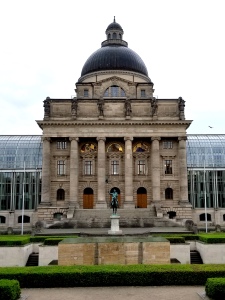 I began to feel more comfortable on the bicycle, and we soon whizzed past the magnificent Bayerische Staatskanzlei (Bavarian State Chancellory), and the ancient-Greece inspired Königsplatz, once seized and reserved by Hitler for parties and events supporting his cause. At one time, it contained temples honouring the Nazis who died in the Beer Hall Putsch, and Hitler’s own ‘Führer’s Building.’ It wasn’t until the 1980s that the square was restored to its original appearance, featuring the Acropolis-like Propylaea gate, the Glyptothek Museum, and the Staatliche Antikensammlungen, built in the style of the Corinthian order, to house Bavaria’s collections from Greece, Rome and Etruria.
I began to feel more comfortable on the bicycle, and we soon whizzed past the magnificent Bayerische Staatskanzlei (Bavarian State Chancellory), and the ancient-Greece inspired Königsplatz, once seized and reserved by Hitler for parties and events supporting his cause. At one time, it contained temples honouring the Nazis who died in the Beer Hall Putsch, and Hitler’s own ‘Führer’s Building.’ It wasn’t until the 1980s that the square was restored to its original appearance, featuring the Acropolis-like Propylaea gate, the Glyptothek Museum, and the Staatliche Antikensammlungen, built in the style of the Corinthian order, to house Bavaria’s collections from Greece, Rome and Etruria.
THE BEST VIEWS IN MUNICH
Still jet-lagged and in desperate need of sugar, Chris directed us toward one of his favourite gelato spots in town, BallaBeni. Our double scoops powered us through a tour of the nearby Ludwig Maximilian University of Munich, after which we cycled to the Technical University of Munich for a well-timed radler on the roof.
The Vorhoelzer Forum is a charming café on top of the school, whose terrace has a nearly 360-degree view of Munich’s skyline. It’s stunning in the late afternoon sun, and if you want the best views, you may need to head there a early, since no reservations are taken.
We watched the sun set from the Maximilianeum, the palatial Bavarian Parliament Building, which sits on a hill at the end of Maximilianstrasse. All of its modern extensions and renovations were well-concealed behind the building, so its Renaissance and Gothic-style façade is still as grandiose as ever. It’s especially beautiful at night, when clever indoor lighting makes the entire building sparkle as if made of gold.
Our day ended with a mouthwatering Afghani meal from Chopan, which serves enough food in a single dish for at least two people, and has warm and velvety traditional indoor décor. A touching bromance backstory to the eatery tops it all off.
Day Two: Munich
If the city’s dedication to green space and top-tier gelato hadn’t already sold me on Munich, the coin machine dispensing pretzels definitely got me.
We were at the grocery store picking up ingredients for a picnic. I had so far been impressed with what Chris had told me about quality of life in Germany, its social welfare system, and how efficiently Munich had rebuilt its heritage buildings after World War II — but the coin pretzel machine was still a fan favourite.
VIKTUALIENMARKT
The recreational triathlete was testing my grit as I attempted to keep up with him on a bicycle for a second day of zipping around the city. I nearly crashed into a BMW on our way to the Viktualienmarkt in the Altstadt, an artisan market that sells not only local crafts and produce but more exotic ingredients that would be tough to find anywhere else in Munich.
The market itself is hundreds of years old, having outgrown is original place in Marienplatz many years ago. Buildings were demolished in the Old Town to make way for its 140 stalls and shops that span 22,000 square metres. If you’re looking for a special kind of Acacia honey, a dried lavender wreath, bison blueberry sausage, or the best hummus you’ve ever had in your life, Viktualienmarkt is the place to go. You’ll pay handsomely for the quality of the product, but take comfort in supporting local producers.
OLYMPIC PARK & BMW WELT
 With our picnic basket full, we made our way to the Olympic Park in the northern half of the city. The site of the 1972 Olympics is a well-known landmark in Munich, complete with ski hills, bike paths, fair grounds, concert venues, swimming pools, an aquarium and more. It’s a most wondrous use of space, given how many abandoned and overgrown Olympic parks there are in the world today, and we weren’t the only ones unrolling a blanket next to the carousels.
With our picnic basket full, we made our way to the Olympic Park in the northern half of the city. The site of the 1972 Olympics is a well-known landmark in Munich, complete with ski hills, bike paths, fair grounds, concert venues, swimming pools, an aquarium and more. It’s a most wondrous use of space, given how many abandoned and overgrown Olympic parks there are in the world today, and we weren’t the only ones unrolling a blanket next to the carousels.
 Just across from the park is the unmistakable BMW Welt. If you ask me, its bizarre shape and glass façade are more eye-catching than the luxury models within, but then again, I have a penchant for being bitter about things I can’t afford. The massive, open-concept facility contains some of the German automaker’s most stunning vehicles, motorcycles and concept cars. It’s all a very clever bit of advertising, and of course, admission is free. There is an entrance fee for the BMW Museum, however, so I’d check out the Welt first before deciding you want to pay for more.
Just across from the park is the unmistakable BMW Welt. If you ask me, its bizarre shape and glass façade are more eye-catching than the luxury models within, but then again, I have a penchant for being bitter about things I can’t afford. The massive, open-concept facility contains some of the German automaker’s most stunning vehicles, motorcycles and concept cars. It’s all a very clever bit of advertising, and of course, admission is free. There is an entrance fee for the BMW Museum, however, so I’d check out the Welt first before deciding you want to pay for more.
NYMPHENBURG PALACE
It was a quick bike ride from the Olympic Park to Schloß Nymphenburg. The regal palace — one of the largest in Europe — and its courtyards were built in the late 1600s for the heir to the Bavarian throne, Maximilian II Emanuel. The grounds are alive with flora and fauna that manages to impress even next to the grandeur of the Baroque architecture. The complex is home to museums of carriages, sleighs and porcelain, and several park palaces: opulently-decorated pavilions and homes built for royal occupants. You can view the gardens for free or pay €15 for a combination ticket that includes entry for everything. It’s €8 to visit the palace alone.
TASTES OF BAVARIA
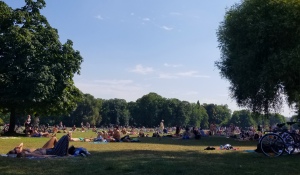 We spent our afternoon lazing away by the human-made banks of the Eisbach, which was just cold enough that I declined to go in past my knees. On a warm August day, the lawns of the Englischer Garten were packed with sunbathers, stretched out on towels next to Bluetooth speakers enjoying a beverage. Afterward, we joined one of Chris’s friends for pretzels and radler at the Chinesischer Turm beer garden. I think prior to arriving in Germany, I had assumed the large crusty pretzels were more of a tourist thing. I was wrong.
We spent our afternoon lazing away by the human-made banks of the Eisbach, which was just cold enough that I declined to go in past my knees. On a warm August day, the lawns of the Englischer Garten were packed with sunbathers, stretched out on towels next to Bluetooth speakers enjoying a beverage. Afterward, we joined one of Chris’s friends for pretzels and radler at the Chinesischer Turm beer garden. I think prior to arriving in Germany, I had assumed the large crusty pretzels were more of a tourist thing. I was wrong.
We took the bicycles next to the PreysingGarten in Haidhausen, a trendy neighbourhood near the Altstadt. I was promised the restaurant and café — one of the oldest in the quarter — served good Bavarian food, so I ordered a classic Vienna schnitzel on a bed of cream sauce and spinach with a side of pasta. It was tasty, but far from the most delicious food I would eat on the trip, which would come the following week in Bosnia.
Day Three: Munich to Zagreb
We kicked off our road trip bright and early, heading southwest on the Bundesautobahn 8. We planned to visit Ljubljana before making our way to Zagreb for the night — but first, we stopped for brunch.
BRUNCH BY THE BOATS
We’ll call it an ‘unsanctioned’ visit to a yacht club that neither Chris, nor I were members of. The grounds were so beautiful and the turquoise water, dotted with white sailboats, was just too tempting to resist. Plus, I needed to use the bathroom.
Prien am Chiemsee is a tourist-friendly town of about 11,000 people, nestled against the stunning ‘Bavarian seaside,’ surrounded by Alpine mountains. The community prides itself on its traditional Upper Bavarian style, and exquisite amenities that draw visitors all year long. In early August, the very air smelled like flowers in bloom.
We parked outside the grounds of the Chiemsee Yacht Club, and walked in with our towels and cooler, hoping to blend in with the couples and families who belonged to the establishment. We sat down on lawn chairs, cracked open containers of fruit, hummus and artichoke dip, and stared out over the sparkling Chiemsee lake. We jumped in the water, used the bathroom, and hit the road while the going was good.
Click here to follow my itinerary to Slovenia, Croatia and Bosnia, or scroll down to see how the adventure ended, back in Munich.
Day 12: Munich (cont’d)
 On Day 12 of our road trip, Chris and I slept in. We had started the previous day in Croatia and spent more than eight hours on the road, and somehow squeezed both a soak at Strandbad Klagenfurt and a visit to Salzburg. In fact, Chris — the stalwart driver — was feeling a little under the weather, so I spent the afternoon revisiting some of my favourite sites in Munich, while enjoying a coffee and pretzel.
On Day 12 of our road trip, Chris and I slept in. We had started the previous day in Croatia and spent more than eight hours on the road, and somehow squeezed both a soak at Strandbad Klagenfurt and a visit to Salzburg. In fact, Chris — the stalwart driver — was feeling a little under the weather, so I spent the afternoon revisiting some of my favourite sites in Munich, while enjoying a coffee and pretzel.
That evening, Chris was feeling better, so we went to a potluck at his friend’s house. Germans eat as well as they cook; some eight kilograms of potatoes went into side dishes serving less than 20 people, and the meat and red current pie were fabulous.
Day 13: Munich to Straubing
We left Munich after nearly two weeks together for the final stop on our trip: Chris’s hometown, a small municipality outside of Regensburg. He kindly indulged me as I checked off a bucket list item for every foreigner in Germany — driving on the speed limit-less highway. I reached 182 kilometres per hour on a lonely, rural stretch of autobahn.
COUNTRY ROADS
The area around Regensburg is rich with agriculture. We passed hops farms, fruit farms and more on our way to Aufhausen, a village of less than 2,000 people southeast of the big city. Chris’s family welcomed me warmly into their home with a traditional Bavarian lunch. While I’m told the schnitzel and cucumber salad we ate are relatively simple dishes, it was among the best home-cooked meals I’ve ever had.
His parents loaned us their electric bicycles to scoot around the quiet village. Chris pointed out the homes of friends and family, and it seemed as though his kin made up half the population of Aufhausen. The area itself is stunning in the summer — lush fields, full fruit trees and sheep everywhere. We could even see Regensburg through a telescope stationed in the village.
GÄUBODENVOLKSFEST
After a quick nap on the hammock in his yard, we got dressed for the main event: the Gäubodenvolksfest in Straubing. It’s the largest fair of its kind in the Bavarian state and stretches 11 days every August. I borrowed a beautiful dirndl from Chris’s cousin and off we went.

The festival was teeming with people in all manner of dresses and leather lederhosen. Kids delighted in the rides and games, while adults gathered around the beer and music tents. The band Gipfelstürmer played on as radler and lager were poured into one-litre steins for about €10 each. We drank and laughed — particularly at the amateur taxidermy decorating the hall — until it was time to go. I got sick not from the beer, but from the oversized broccoli and cheese pretzel I ate. (That’s my story and I’m sticking to it). Chris drove us back to Aufhausen where we caught a few hours of sleep before my flight.
He dropped me off at the airport in Munich early the next morning and we hugged goodbye with another five countries under our belts, two weeks’ worth of memories, and no idea when our next reunion would be.









